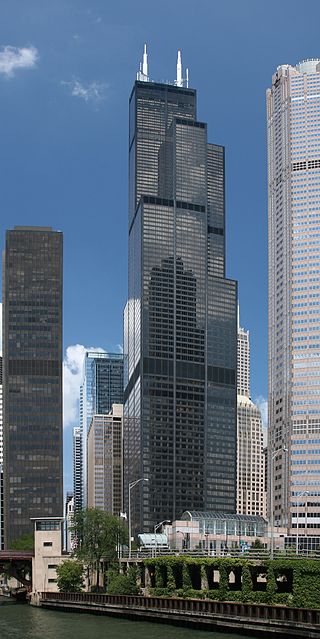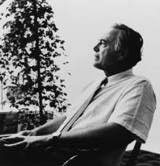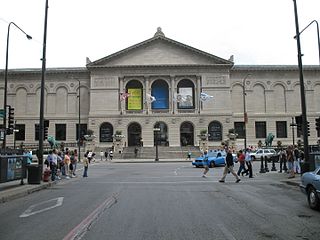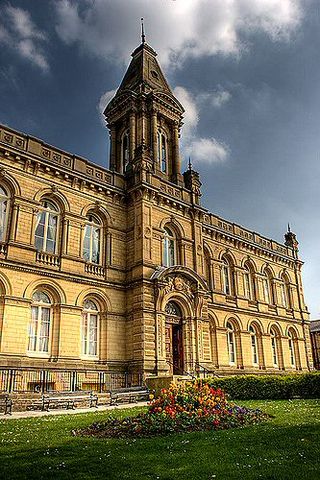
Frank Lloyd Wright Sr. was an American architect, designer, writer, and educator. He designed more than 1,000 structures over a creative period of 70 years. Wright played a key role in the architectural movements of the twentieth century, influencing architects worldwide through his works and mentoring hundreds of apprentices in his Taliesin Fellowship. Wright believed in designing in harmony with humanity and the environment, a philosophy he called organic architecture. This philosophy was exemplified in Fallingwater (1935), which has been called "the best all-time work of American architecture".

Louis Henry Sullivan was an American architect, and has been called a "father of skyscrapers" and "father of modernism." He was an influential architect of the Chicago School, a mentor to Frank Lloyd Wright, and an inspiration to the Chicago group of architects who have come to be known as the Prairie School. Along with Wright and Henry Hobson Richardson, Sullivan is one of "the recognized trinity of American architecture." The phrase "form follows function" is attributed to him, although the idea was theorised by Viollet le Duc who considered that structure and function in architecture should be the sole determinants of form. In 1944, Sullivan was the second architect to posthumously receive the AIA Gold Medal.

Dankmar Adler was a German-born American architect and civil engineer. He is best known for his fifteen-year partnership with Louis Sullivan, during which they designed influential skyscrapers that boldly addressed their steel skeleton through their exterior design: the Wainwright Building in St. Louis, Missouri (1891), the Chicago Stock Exchange Building (1894), and the Guaranty Building in Buffalo, New York (1896).

NYSE Chicago, formerly known as the Chicago Stock Exchange (CHX), is a stock exchange in Chicago, Illinois, US. The exchange is a national securities exchange and self-regulatory organization, which operates under the oversight of the U.S. Securities and Exchange Commission (SEC). Intercontinental Exchange (ICE) acquired CHX in July 2018 and the exchange rebranded as NYSE Chicago in February 2019.
This is a timeline of architecture, indexing the individual year in architecture pages. Notable events in architecture and related disciplines including structural engineering, landscape architecture, and city planning. One significant architectural achievement is listed for each year.

The buildings and architecture of Chicago reflect the city's history and multicultural heritage, featuring prominent buildings in a variety of styles. Most structures downtown were destroyed by the Great Chicago Fire in 1871.

Richard Stanley Nickel was a Polish American architectural photographer and historical preservationist, who was based in Chicago, Illinois. He is best known for his efforts to preserve and document the buildings of architect Louis Sullivan, and the work of the architecture firm of Adler & Sullivan.

The Chicago Cultural Center, opened in 1897, is a Chicago Landmark building operated by Chicago's Department of Cultural Affairs and Special Events. The Cultural Center houses the city's official reception venue, where the Mayor of Chicago has welcomed presidents, royalty, diplomats, and community leaders. It is located in the Loop, across Michigan Avenue from Millennium Park.

Harry Mohr Weese was an American architect who had an important role in 20th century modernism and historic preservation. His brother, Ben Weese, is also a renowned architect.

The Wainwright Building is a 10-story, 41 m (135 ft) terra cotta office building at 709 Chestnut Street in downtown St. Louis, Missouri. The Wainwright Building is considered to be one of the first aesthetically fully expressed early skyscrapers. It was designed by Dankmar Adler and Louis Sullivan and built between 1890 and 1891. It was named for local brewer, building contractor, and financier Ellis Wainwright.

The Bayard–Condict Building is a 12-story commercial structure at 65 Bleecker Street in the NoHo neighborhood of Manhattan in New York City. Built between 1897 and 1899 in the Chicago School style, it was the only building in New York City designed by architect Louis Sullivan, who worked on the project alongside Lyndon P. Smith. Located in the NoHo Historic District, the building was designated a New York City landmark in 1975 and has been a National Historic Landmark since 1976.

The Guaranty Building, formerly called the Prudential Building, is an early skyscraper in Buffalo, New York. It was designed by Louis Sullivan and Dankmar Adler and completed in 1896. The building has been declared a National Historic Landmark and is located within the Joseph Ellicott Historic District.

Jeanne Gang is an American architect and the founder and leader of Studio Gang, an architecture and urban design practice with offices in Chicago, New York, San Francisco, and Paris. Gang was first widely recognized for the Aqua Tower, the tallest woman-designed building in the world at the time of its completion. Aqua has since been surpassed by the nearby St. Regis Chicago, also of her design. Surface has called Gang one of Chicago's most prominent architects of her generation, and her projects have been widely awarded.
The Landmarks Preservation Council of Illinois – also known as Landmarks Illinois – is a not-for-profit organization founded in 1971 to prevent the demolition of the Dankmar Adler and Louis Sullivan designed Chicago Stock Exchange Building. Although this effort failed the organization has grown to become a 2000-member statewide voice for historic preservation.

The Walter H. Gale House, located in the Chicago suburb of Oak Park, Illinois, was designed by Frank Lloyd Wright and constructed in 1893. The house was commissioned by Walter H. Gale of a prominent Oak Park family and is the first home Wright designed after leaving the firm of Adler & Sullivan. The Gale House was listed on the U.S. National Register of Historic Places on August 17, 1973.

The Art Institute of Chicago Building houses the Art Institute of Chicago, and is part of the Chicago Landmark Historic Michigan Boulevard District in the Loop community area of Chicago, Illinois. The building is located in Grant Park on the east side of Michigan Avenue, and marks the third address for the Art Institute. The main building was built for the joint purpose of providing an additional facility for the 1893 World's Columbian Exposition, and subsequently the Art Institute. The core of the current complex, located opposite Adams Street, officially opened to the public on December 8, 1893, and was renamed the Allerton Building in 1968.

The Railway Exchange Building, also known as Santa Fe Building, is a 17-story office building in the Historic Michigan Boulevard District of the Loop community area of Chicago in Cook County, Illinois, United States. It was designed by Frederick P. Dinkelberg of D. H. Burnham & Company in the Chicago style. Dinkelberg was also the associate designer to Daniel Burnham for the Flatiron Building in New York City.

Victoria Hall, Saltaire is a Grade II* listed building in the village of Saltaire, near Bradford, West Yorkshire, England, built by architects Lockwood and Mawson.
John Vinci is a Chicago-based American architect who works on architectural preservation of historic buildings in addition to new designs.

Louis J. Millet was an educator, industrial art school founder, and interior designer in the United States. He was a celebrated stained glass artist. He worked on Louis Sullivan and George W. Maher projects and went into business with portraitist George Healy at the interior design firm Healy & Millet offering services including interior decoration, floor tiling, and wood mantels. Millet was nationally known for his decorative work, frescoes, and stained glass.





















